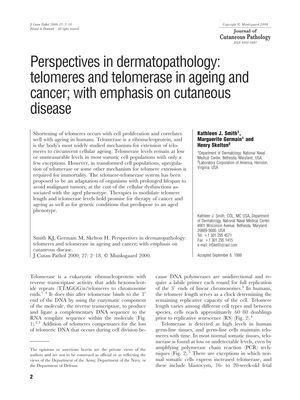Perspectives in Dermatopathology: Telomeres and Telomerase in Aging and Cancer with Emphasis on Cutaneous Disease
January 2000
in “
Journal of Cutaneous Pathology
”

TLDR Short telomeres contribute to aging and cancer, and while telomerase can delay aging, it may also promote cancer.
The document from 2000 explores the connection between telomeres, telomerase, and their roles in aging, cancer, and cutaneous diseases. It explains that telomeres shorten with each cell division, contributing to aging, while telomerase can extend telomeres, potentially delaying aging. However, most somatic cells have low telomerase levels, which may be an evolutionary trade-off to prevent cancer. The paper also discusses how genetic conditions and environmental factors can accelerate telomere attrition, leading to premature aging. It suggests that replicative senescence (RS) is a tumor suppressor mechanism that limits cancer development but may contribute to aging and tissue dysfunction later in life. The document also notes that while most malignant tumors maintain short telomeres, they exhibit high levels of telomerase, which correlates with aggressive behavior. Various therapeutic approaches targeting telomerase in cancer treatment are mentioned, including reverse transcriptase inhibitors and oligonucleotides. Additionally, the potential use of telomerase as a biomarker for cancer diagnosis and monitoring is discussed, as well as its role in other therapeutic contexts, such as skin rejuvenation and the treatment of alopecia. However, the document cautions about the risks of telomerase therapy, including toxicity and the development of resistance.


